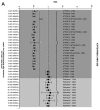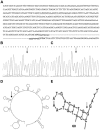A novel gross deletion and breakpoint junction sequence analysis of ATP7B in a Chinese family with Wilson disease using next‑generation sequencing and Sanger sequencing
- PMID: 31746411
- PMCID: PMC6896306
- DOI: 10.3892/mmr.2019.10830
A novel gross deletion and breakpoint junction sequence analysis of ATP7B in a Chinese family with Wilson disease using next‑generation sequencing and Sanger sequencing
Abstract
Wilson disease (WD) is a rare autosomal recessive genetic disorder that causes abnormal copper metabolism, resulting in pathological accumulation of copper in the liver, brain and other organs. Mutations in the ATPase copper transporter 7B (ATP7B) gene, which encodes a membrane P‑type adenosine triphosphatase, have been identified as being responsible for WD. The present study analyzed clinical data and collected DNA samples from a pediatric patient with WD and her healthy parents. Mutation screening for ATP7B was performed using direct sequencing, multiplex ligation‑dependent probe amplification(MLPA), next‑generation sequencing (NGS) and Sanger sequencing of the breakpoint junction sequence. The patient (age, 2.7 years) presented with early‑onset hepatic disease. The present study identified compound heterozygous mutations of ATP7B, including a heterozygous mutation (p.Arg1,041Trp) and a novel heterozygous gross deletion of a 57,771 bp fragment (chr13: 52490972‑52548742) (GRCh37) from partial exon2‑ exon21 to external ATP7B sequence (15.833bp) in the patient. Analysis of the family members of the patient showed that the missense mutation and the gross deletion mutation were inherited from her mother and father, respectively. Microhomology and inverted repeat sequences, which may mediate the deletion mutation, were identified through sequence analysis on both sides of the breakpoints of this deletion. The present study provided additional information on the genotypic spectrum of the ATP7B gene, particularly with regard to early onset hepatic disease, as observed in the present patient with WD. The identification of the precise breakpoint junction sequence warrants further investigation of DNA break and recombination mechanisms. In detecting precise deletions, the NGS associated with Sanger sequencing of breakpoint junction sequence have been found to have more advantages than MLPA.
Keywords: Wilson disease; child; aTPase copper transporter B; next-generation sequencing; mutation.
Figures





References
-
- Danks DM. Disorders of copper transport. In: Scriver CR, Beaudet AL, Sly WS, Valle D, editors. The metabolic basis of inherited diseases. 6th. Vol. 1. McGraw-Hill; New York, NY: 1989. pp. 1416–1422.
-
- Scheinberg IH, Sternlieb I. Wilson disease. In: Lloyd H, Smith J, editors. Major Problems in Internal Medicine. Saunders; Philadelphia, PA: 1984.
MeSH terms
Substances
LinkOut - more resources
Full Text Sources
Medical
Research Materials
Miscellaneous

